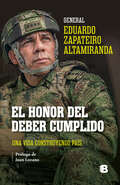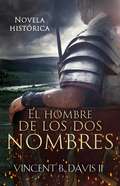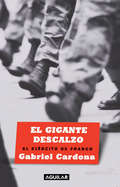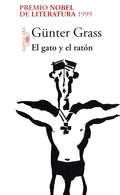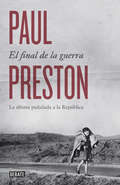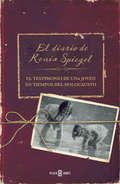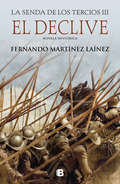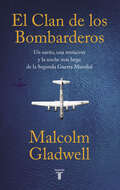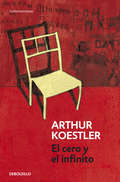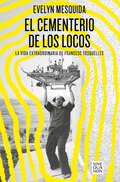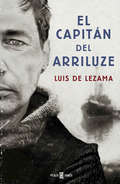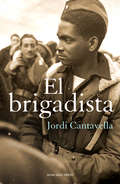- Table View
- List View
El invierno del mundo (The Century #Volumen 2)
by Ken FollettLos hijos de las cinco familias protagonistas de La caída de los gigantes forjarán su destino en los años turbulentos de la Segunda Guerra Mundial, la guerra civil española, el bombardeo de Pearl Harbor y la era de la bomba atómica. Segundo volumen de la trilogía «The Century» En el año 1933, Berlín es un foco de agitación política y social. Lady Maud, ahora la esposa de Walter von Ulrich y madre de dos hijos, publica en una revista semanal artículos que ridiculizan al Partido Nazi, mientras que Walter manifiesta su oposición en el Parlamento. Sin embargo, parece que nada podrá frenar el poder ascendente del canciller Adolf Hitler. Cuando Ethel Williams y su hijo Lloyd visitan a la familia von Ulrich, todos serán testigos de la tiranía y la represión de la nueva Alemania. El dominio del Tercer Reich se extenderá hasta Francia y más allá de la frontera rusa. Mientras, en Inglaterra, Lloyd Williams, activista político como su madre, luchará en el ejército británico para intentar frenar el avance de los nazis y se alistará en las brigadas internacionales durante la guerra civil española. Participará en la ofensiva de Zaragoza y la batalla de Belchite. En Ty Gwyn, la mansión familia de los Fitzherbert en Gales, se alojarán los oficiales británicos y, durante su estancia, el teniente Lloyd Williams se sentirá atraído por la mujer de Boy Fitzherbert, la rica heredera americana Daisy Peshkov. «La trilogía "The Century" es la historia de mis abuelos y de los vuestros, de nuestros padres y de nuestras propias vidas. De alguna forma es la historia de todos nosotros.»Ken Follett La crítica ha dicho...«La saga atrapa y la intensidad de los personajes te sumerge en el relato. Un trabajo de plena coherencia, cohesión y pulcritud.»Ramón Ventura, El Periódico de Catalunya «Un melodrama épico y generacional en el que se pone de manifiesto lo mejor y lo peor del ser humano.»La Razón
El honor del deber cumplido
by Eduardo Zapateiro Altamiranda"LA VOZ DE EDUARDO ZAPATEIRO DEBE SER ESCUCHADA. ES NECESARIO. ES DEMOCRÁTICO. ES CONVENIENTE. ES URGENTE". Del prólogo de Juan Lozano El 20 de julio del 2022 el general Eduardo Zapateiro Altamiranda, quien era el comandante del Ejército nacional, anunció que se retiraba de su cargo por sus discrepancias de fondo con el presidente electo Gustavo Petro. El general tomó esta dramática decisión para preservar el honor militar, que consideraba vulnerado después de las diversas acusaciones realizadas en contra de la institución por quien en los próximos días asumiría la presidencia y sería, además, el comandante supremo de las Fuerzas Militares. En estas memorias sinceras y reveladoras son protagonistas por igual la vida de Eduardo Zapateiro y la historia de Colombia; el general ha sido testigo y actor de primer orden de momentos cruciales del pasado reciente del país, y por el caudal de su experiencia, y por la atención y la pasión con las que sigue nuestra convulsa actualidad, sus palabras tienen hoy un enorme valor para abordar el presente y para reflexionar sobre qué futuro es posible construir
El homenaje
by Andrea CamilleriEn este inteligente y divertidísimo relato cargado de ironía, Andrea Camilleri apunta, una vez más, a la cara más absurda del ser humano. Como en la mejor obra de teatro, las intenciones de los personajes se revelan ante nuestros ojos a través de las mentiras que profieren sin pudor y, entre una maraña de leyendas engañosas y honores trasnochados, la realidad termina asomando la cabeza y delatando a los farsantes. El 11 de junio de 1940, Italia entera celebra la entrada en guerra como si fuera un «billete de lotería premiado». En Vigàta, tras cinco años de confinamiento por «difamación sistemática del glorioso régimen fascista», Micheli Ragusano se presenta de improviso en el Círculo Fascismo y Familia. Como era de esperar, nadie lo saluda, pero los ánimos se encrespan y la tensión sube hasta que Manueli Persico, ferviente fascista de noventa y siete años, cae fulminado por un infarto. Empieza así una curiosa y disparatada ronda de homenajes y celebraciones póstumos, en la cual, entre verdades soterradas y sospechas maquilladas, cada uno ejercita a su manera ese arte tan sutil propio de todas las épocas: el revisionismo y la componenda. Reseñas:«Un relato vivaz y fantasioso que, con el gusto por la diversión y la sagacidad de una mirada ejercitada en captar la caricatura, desenmascara apariencias y hace aflorar la realidad.»Solo Libri «Un relato ejemplar.»Cristina Taglietti, Corriere della Sera «Nos hace pensar en Pirandello, el otro grandísimo autor de Agrigento, cuyas obras a menudo ilustran lo difícil que es definir y comprender al prójimo, fragmentado en mil máscaras e historias. [...] Una lectura audaz, divertida y ágil.»Thrillercafe.it
El hombre de los dos nombres
by Vincent B. Davis IIRoma, 107 AC. Quinto Sertorio acaba de perder a su padre y podría perder también su hogar. Cuando su aldea rural pierde su estatus político, debe abandonar a su familia para garantizar la supervivencia y protección de su aldea desde el interior del despiadado gobierno. Mientras se convierte de campesino en político, se verá enredado en medio de una amarga guerra política... A medida que Quinto lucha para ganarse la ayuda que tan desesperadamente necesita su aldea, conoce a Cayo Mario -el tío de Julio Cesar. Pero, con cada día que pasa en la implacable Ciudad Eterna, el riesgo para su familia y su propia vida es aún mayor. En esa cruel batalla moral, ¿se perderá Quinto a sí mismo y a aquellos a los que ama? El hombre de los dos nombres es el primer libro de la serie de ficción histórica sobre Sertorio. Si le gustan las ambiciones heróicas, los ambientes históricos exhaustivamente investigados y la corrupción romana... le encantará esta poderosa historia de Vincent B. Davis II.
El holocausto español: Odio y exterminio en la Guerra Civil y después
by Paul PrestonLa represión durante la guerra y en la inmediata posguerra contada por el más prestigioso hispanista de la actualidad. «Durante la Guerra Civil española, cerca de 200.000 hombres y mujeres fueron asesinados lejos del frente, ejecutados extrajudicialmente o tras precarios procesos legales, y al menos 300.000 hombres perdieron la vida en los frentes de batalla. Además, un número desconocido de hombres, mujeres y niños fueron víctimas de los bombardeos y los éxodos que siguieron a la ocupación del territorio por parte de las fuerzas militares de Franco. En el conjunto de España, tras la victoria definitiva de los rebeldes a finales de marzo de 1939, alrededor de 20.000 republicanos fueron ejecutados. Muchos más murieron de hambre y enfermedades en las prisiones y los campos de concentración donde se hacinaban en condiciones infrahumanas. Otros sucumbieron a las condiciones esclavistas de los batallones de trabajo. A más de medio millón de refugiados no les quedó otra salida que el exilio, y muchos perecieron en los campos de internamiento franceses. Varios miles acabaron en los campos de exterminio nazis. »Todo ello constituye lo que a mi juicio puede llamarse el «holocausto español». El propósito de este libro es mostrar, en la medida de lo posible, lo que aconteció a la población civil y desentrañar los porqués.»Paul Preston Reseña:«Debiera ser de lectura obligada no solo para los interesados por nuestro pasado sino, y sobre todo, para los educadores de las generaciones futuras.»Ángel Viñas, Babelia, El País
El haiku de las palabras perdidas
by Andrés PascualHaiku: poema japonés de diecisiete sílabas;destello fugaz que nos muestra la esencia de las cosas. Nagasaki, agosto de 1945: Kazuo, un muchacho occidental afincado en Japón, y Junko, la bella hija de una diseñadora de arreglos florales, han acordado encontrarse en una colina para sellar su amor adolescente con un haiku que esconde un secreto sobre su relación. Minutos antes de su cita, la bomba atómica convierte la ciudad en el peor de los infiernos. Tokio, febrero de 2011: Emilian Zäch, un arquitecto suizo, asesor de Naciones Unidas y defensor de la energía nuclear, cuya vida está desmoronándose, conoce a una galerista de arte japonesa obsesionada con encontrar al antiguo amor de un familiar. A través de estas dos historias paralelas y de su sorprendente encuentro final, Andrés Pascual teje una conmovedora trama sobre la importancia de asimilar las tragedias del pasado para afrontar los retos del presente y escribir nuestro propio destino. La crítica ha dicho...«Libro hermoso, dotado de un estilo eficaz; enlaza dos historias apasionantes.»Juan Ángel Juristo, ABC Cultural
El gigante descalzo: El ejército de Franco
by Gabriel CardonaEl ejército de Franco por dentro. Durante el franquismo, el Ejército concentraba las mayores reservas de poder aunque solo ejercía bajo la batuta del dictador. La enorme organización era arrolladora en el interior y tigre de papel en el extranjero y, bajo su imponente y uniforme apariencia, escondía un mundo desordenado y empobrecido. Durante el mandato de Franco, se sucedieron tres generaciones distintas de militares, el principal modelo de referencia evolucionó desde el alemán al norteamericano y toda la sociedad española se transformó profundamente.
El gato y el ratón (Trilogía de Danzig #2)
by Günter GrassLa crónica apasionada de unas adolescencias quebradas por la guerra, que les hace salir de su mundo juvenil para enfrentarse con la catástrofe de un entorno en conflicto y en descomposición. En El gato y el ratón encontramos el mismo escenario de obras anteriores de Günter Grass, Danzig; un periodo de tiempo que ya había tocado 1939-1945 y un grupo de personajes que ya había aparecido en otros de sus libros. Sin embargo, hay un elemento que por primera vez trata en extensión: el amor. El grupo de adolescentes que en el primer verano nadan hasta un barco semihundido y lo convierten en mítica isla donde fantasear aventuras personales es el mismo que muy poco tiempo después, recién abandonado el pantalón corto, tendrá que ir al frente. Una novela breve en la que Grass bucea el mundo dolorido de la adolescencia de manera magistral.
El fundamentalista reticente
by Mohsin HamidUn profundo retrato del camino que lleva a un inmigrante del sueño americano a la disidencia pakistaní. Una novela con una sólida posición ética que nos hace plantearnos en qué mundo queremos vivir. En un bullicioso mercado de Lahore, Changez le explica a un desconocido de Estados Unidos cómo él mismo encarnó el sueño americano: dejó Pakistán, estudió en Princeton y trabajó como asesor financiero en Nueva York. Instalado en la élite, acostumbrado a pasear del brazo de la bella Erica por los mejores restaurantes, todo cambió con el 11-S. Su idilio americano se desmoronó con las torres gemelas. Sin trabajo, se dejó crecer la barba mientras veía cómo su país de acogida utilizaba su país de origen como peón en una guerra donde la muerte se aliaba con el mercado capitalista. Con la fluidez de un thriller y la profundidad de un tratado político, Hamid demuestra en este monólogo que la violencia no nace por combustión espontánea, sino que llega al final de un goteo de sospechas, torturas y bombardeos. La crítica ha dicho...«El fundamentalista reticente es una novela valiente, con la fluidez de un relato policial y una notable clarividencia política.»Rafael Narbona, El Cultural «Una de esas novelas dolorosamente ciertas que te hacen agradecer ser lector.»Junot Díaz «Los tiempos extremos llaman a reacciones extremas, a escrituras extremas. Hamid ha hecho algo extraordinario con esta novela.»The Washington Post «Uno de los escritores más ingeniosos y dotados de su generación.»The New York Times «Hamid hace gala de una clara e infalible compresión de nuestro tiempo y de sus cuestiones más urgentes.»The New Yorker «Un thriller impresionantemente inteligente. [...] Mientras "guerra contra el terror" retumba, este es un libro afilado e importante. Ejecutado con un control frío y fresco, es un microcosmos de laatmósfera desospecha entre Oriente y Occidente. Una obra que entretiene al mismo tiempo que te hace pensar.»The Telegraph
El final del desfile
by Ford Madox FordUna de las obras maestras de la literatura del siglo XX por primera vez traducida al castellano. Justo antes de que caiga la era eduardiana, en los albores de la I Guerra Mundial, toma lugar esta historia de traición, romance y el horror de las trincheras. En el centro de la narración está la escandalosa separación de Christopher Tietjens, un clásico caballero inglés, conservador y convencional, e impecable súbdito de la corona inglesa, y su esposa Sylvia, una mujer bella, arrogante, contestataria y símbolo de los nuevos tiempos. Christopher ve cómo su matrimonio se desborona mientras Europa es consumida por la tragedia.
El final de la guerra: La última puñalada a la República
by Paul PrestonEsta es la historia de una tragedia evitable que costó muchos miles de vidas y arruinó decenas de miles más. Tiene numerosos protagonistas, pero se centra en tres individuos. El primero, el doctor Juan Negrín, víctima de lo que se podría llamar una conjura de necios, trató de impedirla. Los otros dos fueron responsables de lo acontecido. Uno, Julián Besteiro, actuó con una asombrosa ingenuidad. El otro, Segismundo Casado, con una sorprendente combinación de cinismo, arrogancia y egoísmo. El resultado fue una catástrofe humanitaria y el peor final posible para la tragedia que fue la guerra de España.
El fin de la guerra rusa en Ucrania: Los Agentes Rusos: Libro 4 (Los Agentes Rusos #4)
by Ted HalsteadAgentes rusos buscan en Ucrania una ojiva nuclear desaparecida. Estados Unidos sospecha que la ojiva no ha sido robada y que su detonación es un pretexto para que Rusia se apodere de Ucrania. ¿Encontrarán los agentes la cabeza nuclear antes de que sea utilizada y dé comienzo la Tercera Guerra Mundial? Publishers Weekly: "El impresionante cuarto thriller de los Agentes Rusos de Halstead evita las convenciones trilladas del género... Los fans de las novelas de espionaje se deleitarán".
El fin de la guerra de los Estados Unidos en Afganistán: Los Agentes Rusos: Libro 3 (Los Agentes Rusos #3)
by Ted HalsteadLas tropas estadounidenses abandonaron Afganistán. Pero, al igual que en Irak, pronto se vieron obligadas a regresar. Tres agentes rusos intentan detener las armas nucleares robadas a Pakistán por los talibanes. Los talibanes quieren utilizar las armas robadas para obligar a Estados Unidos a abandonar Afganistán para siempre. ¿Les permitirán los ataques nucleares en múltiples lugares de Afganistán tener éxito? ¿O podrán los agentes rusos y las fuerzas especiales estadounidenses detener a los talibanes a tiempo? "El autor se ha esforzado mucho, más que la mayoría, en justificar las acciones de cada una de las naciones implicadas, especialmente Rusia. Al menos para mí, eso le da al libro mucho más realismo y lo convierte en una historia mucho más interesante. El desarrollo de los personajes también es estupendo. Uno se involucra en la historia. Por último, como veterano de la USAF, su uso del ejército y las descripciones de las personalidades implicadas son excepcionales".
El enemigo (Colección Endebate #Volumen)
by Christopher HitchensCon la muerte de Osama bin Laden el mundo pareció cerrar una época. Christopher Hitchens reflexiona acerca de la figura que atemorizó a Occidente durante diez años, su final y su sangriento y funesto legado. Todo cambió el 11 de septiembre de 2001 cuando 19 terroristas suicidas secuestraron cuatro aviones y sembraron el caos y la destrucción. El siglo XXI comenzaba cubierto de sangre y barro y el espectro de Al Qaeda y su líder, Osama bin Laden, ocuparon un espacio inusitado en el imaginario global. Desde la seguridad en los aeropuertos hasta las guerras de Afganistán e Iraq, la onda expansiva de esos atentados aún se hace notar. Diez años más tarde Estados Unidos acabó con su principal enemigo, pero ¿qué representaba Bin Laden? Más aún, ¿quién era y qué había conseguido? Esas son las preguntas que la incisiva pluma de Christopher Hitchens intenta responder.
El ejército de Chile y la soberanía popular: Ensayo Histórico
by Gabriel Salazar VergaraLa investigación más importante de Gabriel Salazar aborda la historia del ejército de Chile y su relación con la ciudadanía desde la Independencia hasta nuestros días. En un trabajo monumental escrito como ensayo histórico, Gabriel Salazar recorre la historia del ejército de Chile y su rol en los acontecimientos políticos y sociales ocurridos durante los últimos doscientos años. Desde sus distintas mutaciones ocurridas durante el siglo XIX (del ejército libertador de O'Higgins hasta el ejército privado que derrocó al gobierno de Balmaceda), pasando por el caudillismo ibañista, las sublevaciones del general Viaux al «frustrado caudillismo del capitán general Augusto Pinochet», Salazar indaga en su relación con la clase política y civil, así como con su relación con el bajo pueblo (la "pacificación" y el "palomeo"), para finalmente ofrecer un balance histórico de su cuestionado protagonismo en la historia nacional.
El diario de Renia Spiegel: El testimonio de una joven en tiempos del Holocausto
by Renia SpiegelTras permanecer oculto más de setenta años, sale a la luz el diario de una joven judía polaca que relata su adolescencia y sus últimos días durante el Holocausto. Un testimonio de vida profundamente humano, veraz e impactante.Un legado de poesía y amor. Miércoles, 15 de julio de 1942 «Recuerda este día, recuérdalo bien. Se lo contarás a las generaciones que están por venir. Desde las ocho de hoy estamos encerrados en el gueto. Ahora vivo aquí. El mundo está aislado de mí y yo estoy aislada del mundo.» Renia Spiegel tiene quince años y es una adolescente como muchas otras. Le gusta escribir poesía, reunirse con las amigas y divertirse. Pero Renia es judía, vive en Polonia y estamos en 1939. Con el inicio de la Segunda Guerra Mundial, su mundo empieza a desmoronarse. Ese mismo año comienza un diario. En él relata su adolescencia marcada por la añoranza de su madre, por la amistad y por el amor, además de las atrocidades que la rodean. Pese a todo, el diario es un texto lleno de sensibilidad y ganas de vivir, en el que Renia menciona también la pena que siente por los soldados alemanes que ve desfilar a través del muro, tan jóvenes, tan lejos de sus seres queridos y tan cerca de la muerte. Asimismo, describe emocionada la primera vez que besa a su novio, cuatro horas antes de que los nazis invadan la Unión Soviética, sus miedos y las terribles humillaciones durante la creación del gueto. Será precisamente el chico quien firmará la desgarradora última entrada del diario, tres años después de que Renia lo empiece. Este extraordinario y conmovedor relato, rescatado en condiciones increíbles, llegó a manos de la madre y la hermana de Renia, quienes sobrevivieron al Holocausto, y ha permanecido oculto durante más de siete décadas, hasta la actualidad. _________________________________________________________________ Este testimonio inédito viene acompañado por una introducción de la historiadora estadounidense Deborah Lipstadt y un cuadernillo de fotos, así como por un prefacio, un epílogo y unas notas de Elizabeth Bellak, la hermana menor de la autora. «Durante la lectura del diario recordé, como les sucederá a muchos lectores, la icónica obra de Anne Frank. A Renia Spiegel, una joven llena de amor por la vida y que poseía la habilidad de describir la belleza del mundo que la rodeaba, se le negó con una bala lo que tanto quería: un futuro. De no ser por este diario, habría terminado, junto a otros millones de personas, en el cruel olvido que la mayoría de las víctimas del Holocausto tuvieron como destino. La han "rescatado" quienes conservaron el diario y quienes trabajaron para publicarlo. No pudieron salvarla de su cruel final, ni pudieron darle el futuro que tanto ansiaba, pero la rescataron del dolor añadido de ser olvidada.»Deborah E. Lipstadt, profesora Dorot de Historia del Holocausto en la Universidad de Emory Reseñas:«Han comparado a Renia Spiegel con Anne Frank por su conmovedor testimonio sobre la vida de los judíos durante la ocupación nazi de Polonia.»The Guardian «En una época donde el Holocausto queda tan lejos que incluso los supervivientes más jóvenes son ya ancianos, es especialmente potente descubrir una voz juvenil como la de Renia, que describe los acontecimientos en tiempo real.»Revista Smithsonian
El declive (La senda de los Tercios #Volumen 3)
by Fernando Martínez LaínezEl apasionante cierre de la trilogía narra la épica batalla que marca el ocaso de la supremacía militar de Los Tercios de Flandes. Las fronteras del imperio español se tambalean ante unos enemigos cada día más fuertes y organizados. Con el propósito de aliviar la presión del ejército francés sobre Cataluña, los tercios de Flandes, con Francisco de Melo al frente, invaden el norte de Francia y sitiían la ciudad de Rocroi. En una batalla que parece ganada de antemano, los españoles se ven rodeados por las tropas de un joven Luis de Borbón. Por primera vez, los tercios se enfrentan a una posible derrota, pero eso no será suficiente para que ningún soldado deje de luchar con la valentía y heroicidad por la que se convirtieron en leyenda. Esta novela recrea de forma magistral la fuerza y el carácter de los tercios de Flandes y culmina una trilogía en la que queda reflejado cómo se convirtieron en Historia.
El cuerpo humano
by Paolo GiordanoDel autor de La soledad de los números primos, una conmovedora novela de iniciación entre la juventud y la edad adulta: un relato que nos recuerda lo que significa ser humano. Situada en pleno desierto, rodeada de un inmenso mar de arena y castigada por una luz tan fulgurante que ciega la vista, la base avanzada de operaciones Ice se encuentra en un remoto y peligroso enclave de Afganistán. Hasta allí se traslada el último pelotón de voluntarios comandados por el subteniente Antonio René, un grupo de jóvenes inexpertos que se enfrentan a la primera gran prueba de sus vidas. En la base les espera el teniente médico Alessandro Egitto, quien ha decidido prolongar su servicio para escapar de unas circunstancias familiares para él más lacerantes que la guerra misma. Así, intentando acostumbrarse al calor, al aburrimiento, a la espera de enfrentarse a una amenaza sin rostro que por lejana y desconocida resulta casi irreal, los chicos se construyen una nueva existencia, traban nuevas amistades, afectos y rivalidades. Sin embargo, en el silencio absoluto de la noche, tumbados en sus jergones, cuando los recuerdos de sus vidas desfilan por su mente, sOlo oyen el latir de sus corazones, el rumor incesante del cuerpo humano. Críticas:«Habilidad [...] gran equilibrio, credibilidad. Este segundo libro es un avance definitivo que demuestra la madurez adquirida desde su primera novela.»Corriere della Sera «Una novela guiada con mano firme, cargada de meditadas sugerencias. Mucho más que la confirmación de un talento.»La Stampa «Hace falta mucho valor para, cinco años después de un éxito arrollador, reaparecer con una novela que habla de la guerra, del dolor, de la traición. Pero El cuerpo humano dejará huella. Es un libro hermoso y valiente, cuyos protagonistas no son héroes ni quieren serlo, con personajes que se nos muestran en toda su fragilidad.»Vanity Fair «Los personajes de Paolo Giordano padecen un trauma familiar que este autor desmenuza con rigor, armado con una sensibilidad quirúrgica y una escritura creíble tanto en las descripciones como en los diálogos. [...] páginas espléndidas, imprescindibles.»La Stampa
El clan de los bombarderos: Un sueño, una tentación y la noche más larga de la Segunda Guerra Mundial
by Malcolm GladwellLa Segunda Guerra Mundial contada desde el aire. ¿Qué ocurre cuando la tecnología y las mejores intenciones chocan en el fragor de las batallas? «Excepcional, una obra maestra».The Wall Street Journal Durante los años previos a la Segunda Guerra Mundial, en una base aérea de Alabama, un grupo de pilotos renegados forjó una idea radical. ¿Qué pasaría si los bombardeos fueran tan precisos como para que las guerras pudieran librarse solamente desde el aire? ¿Podrían los brutales enfrentamientos entre ejércitos de tierra convertirse en cosa del pasado? Este libro cuenta lo que ocurrió cuando intentó llevarse a la práctica ese sueño. Malcolm Gladwell sigue los pasos de un genio holandés y su ordenador analógico casero, del grupo de científicos pirómanos de Harvard que inventaron el napalm, de un brillante piloto que cantaba tonadas a su equipo y del comandante LeMay, quien ordenaría uno de los ataques más sangrientos de la Segunda Guerra Mundial. A su más puro estilo, Gladwell les saca jugo a todos estos personajes fascinantes y nos lleva ágilmente a través de una serie de dilemas que cambiaron el rumbo de la historia para para preguntarnos cuál puede llegar a ser, a menudo, el precio del progreso. La crítica ha dicho:«Excepcional, una obra maestra. Uno acaba este libro sacudiendo la cabeza ante la locura y el coste humano que acarreó todo lo que narra».The Wall Street Journal «Cautivador. En las hábiles manos de Gladwell, los generales de la Fuerza Aérea de la Segunda Guerra Mundial vuelven a la vida. Me hubiera encantado que fuera el doble de largo».New York Times Book Review «Una fábula brillantemente contada e ideal para la era de los cambios tecnológicos».The Sunday Times «Otro libro de Gladwell que confirma que todo lo que creía saber era falso».Kirkus «Gladwell es posiblemente el narrador más solvente de la no ficción. Siempre sabe hacia dónde va y te lleva con él en un viaje que siempre resulta placentero y cómodo».The New Statesman «Fascinante. Uno de los mayores desafíos morales de la Segunda Guerra Mundial»Michael Lewis «La narración enérgica y los personajes reales e increíblemente carismáticos son propios del cine».Radio Times «Un relato accesible y estimulante. El estilo ameno y desenfadado de Gladwell es eficaz, y sus retratos de individuos son cautivadores».The Washington Post «De una empatía sorprendente y una energía fabulosa».Esquire «Vívido y cautivador. Una historia fascinante».The Times «Un relato repleto de anécdotas sobre lo que condujo al ataque aéreo más mortífero de la Segunda Guerra Mundial. Gladwell ofrece detalles coloridos y plantea interesantes cuestiones sobre la moralidad de la guerra».Publishers Weekly «Apasionante. Una escritura absorbente».The Telegraph
El cero y el infinito (Destinolibro. Bolsil Ser. #Vol. 20)
by Arthur KoestlerPublicada originalmente en 1941, El cero y el infinito es la obra maestra de Arthur Koestler, un retrato estremecedor del totalitarismo y sus mecanismos de destrucción moral. Durante las purgas estalinistas, el viejo revolucionario Nicolás Rubachof es encarcelado y sometido a tortura psicológica por el partido al que ha dedicado toda su vida. La presión que el régimen ejerce sobre él terminará por mostrarle la ironía y la vileza de una dictadura que se cree instrumento de liberación. ** Prólogo de Mario Vargas Llosa Reseña:«Koestler nos legó una obra que siempre resultará atractiva y estimulante a quienes admiren a los hombres de principios o disfruten sin más de las batallas de ideas.»Christopher Hitchens
El cementerio de los locos
by Evelyn MesquidaEste libro relata la increíble vida de Francesc Tosquelles, psiquiatra catalán que revolucionó los servicios de la psiquiatría con métodos tan innovadores como revolucionarios. Siendo muy joven y en plena Guerra Civil, Tosquelles trabajó como jefe de los servicios psiquiátricos del ejército republicano tratando a soldados con estrés postraumático. Exiliado al final de la guerra, fue capturado y trasladado como prisionero al campo francés de Septfonds, donde creó un centro psiquiátrico para servir a los refugiados considerados «extranjeros indeseables» y afectados por patologías físicas y mentales. Una vez liberado, aplicó su método de trabajo conocido como «psicoterapia institucional» en el hospital psiquiátrico de Saint-Alba n-Sur-Limagnole, inaugurando así una importante etapa renovadora de la psiquiatría en Francia. Durante la Segunda Guerra Mundial, cuando en los psiquiátricos franceses murieron más de cincuenta mil enfermos mentales de inanición a causa las políticas del régimen de Vichy, en el hospital de Saint-Alban no solo no murió de hambre ningún interno, sino que se acogió a heridos de la Resistencia y se ocultó a ciertos artistas perseguidos, como al poeta Paul Éluard o a Tristan Tzara. En el pequeño pueblo de Saint-Alban existían dos cementerios: el que lindaba con la comunidad psiquiátrica, lo llamaban «el cementerio de los locos». Evelyn Mesquida recoge los testimonios de diversos especialistas y personas cercanas a Tosquelles, gracias a los que es posible perfilar la silueta humana y la identidad apasionante y compleja de este personaje excepcional.
El capitán del Arriluze
by Luis LezamaConspiraciones, secretos y misterios en pleno estallido de la guerra civil española.Una historia real, épica y trágica sobre el significado de la lealtad. «Solo Luis de Lezama podía escribir esta novela, una historia personalen tiempos de guerra que me ha emocionado profundamente.»Julia Navarro Corre el verano de 1936 y la situación política en España se ha complicado en extremo en los últimos meses. En cada puerto se tejen conspiraciones de todo signo pero ninguna de ellas logra empañar la felicidad de Poli Baraño, quien acaba de cumplir su gran sueño: comprar el buque en el que ha trabajado casi toda su vida, el Arriluze. Zarpa de Valencia en los primeros días de julio con la ilusión de arribar pronto a Bilbao y así celebrar con los suyos el nacimiento de su primer nieto, al que todavía no conoce. Antes de partir es abordado por dos hombres que se identifican como agentes al servicio de la República y que le piden que lleve a cabo una misteriosa misión bajo el nombre en clave de Yerma. Solo podrá saber de qué se trata una vez se encuentre en alta mar. La travesía tendrá, además, invitados inesperados: la actriz republicana y musa de Federico García Lorca, Margarita Xirgu, y un sospechoso inspector de vapores llamado Jacobo Leguina. La sublevación militar del 18 de julio les encuentra en el Estrecho de Gibraltar, trastocando por completo los planes de todos. La situación se vuelve más delicada de día en día: cada puerto es una incógnita, la vida del pasaje corre peligro y los malos presagios se suceden en un mar de tinieblas, iluminado por los fogonazos de una guerra fratricida. «Descubrí que los barcos tienen alma. El alma es propiedadde las personas que los mandan. Navegan según el alma. Unbarco sin alma es un cuerpo vacío. Puede ser arrastrado porel viento o llevado por las corrientes hasta el naufragio.»
El caballero del Grifo: El caballero del Grifo
by Laura FaccioSiena, año del Señor 1298. La bella Elena Bonsignori es el sueño prohibido de cualquier hombre. Cabello largo y negro, ojos insondables y el cuerpo sinuoso de una diosa. Será ella quien premiará al ganador del torneo que su hermano Filippo organizó en la Piazza del Campo. Pero los planes de Filippo no se detienen ahí. Para recuperar la gloria que su familia perdió, está listo para esclavizar a todo un pueblo. Entre amores, batallas, traiciones y sorpresas, existe un obstáculo ante los sueños de poder de Filippo. Se llama Bino de los Abate de Malia. Una novela histórica que da voz a los héroes sin rostro, narrando una batalla tan antigua como el mundo: la lucha contra la opresión, la lucha por la libertad.
El brigadista
by Jordi Cantavella"Sigues una brigadista de la teva vida i lluita per les teves ganes de viure, lluita a cops de fusell contra el feixisme del fracàs i de la infelicitat"De la ma d'un brigadista americà que va lluitar a la Guerra Civil espanyola, ens endinsem en una història emotiva que vol ser un merescut homenatge als milers d'homes i dones, herois vinguts d'arreu del món, que van lluitar i donar la seva vida a casa nostra defensant la llibertat de tots.
El beso francés: Cómo los estadounidenses y los franceses se enamoraron y desencantaron durante la Guerra Fría
by Steve BassettEn 1951, Francia estaba lejos de la recuperación de la Segunda Guerra Mundial y con la caída de los nazis, estaba a punto de comenzar una nueva ocupación militar totalmente diferente. Con los Estados Unidos como punta de lanza, la OTAN estaba avanzando. Al acecho, con todas sus armas, estaba el Partido Comunista Francés. El odio antiestadounidense que se escupía en periódicos y revistas, así como en las emisoras de radio controladas por el partido, resultó insuficiente para detener la construcción de trece bases aéreas estadounidenses que se establecieron en suelo francés, incluido el mayor depósito de suministros aéreos de Europa en Berry, la región más empobrecida del centro de Francia, la estación aérea de Déols-Châteauroux. Es aquí donde comienza nuestra insólita historia de amor franco-estadounidense. No sólo los comunistas, sino también otros grupos antiestadounidenses se unieron a los ataques contra el Tío Sam. El bombardeo publicitario incluía la condena del comportamiento de los soldados, grafitis de «Estadounidenses, váyanse», panfletos en las esquinas, peleas a puñetazos y, en un momento dado, el bloqueo e intento de cierre del CHAS. Los cientos de horas de entrevistas y las fotografías olvidadas hace mucho tiempo proporcionan por primera vez una fusión única de voces que rara vez se escuchan. Ciudadanos franceses y estadounidenses describen cómo sus primeros recelos se transformaron en un aumento de confianza, amistad y, en varios casos, amor y matrimonio. La base aérea mostró la riqueza de los estadounidenses creando un gueto de oro que proporcionaba a los ciudadanos locales una seguridad económica hasta entonces inimaginable. Pero esto no era un lugar exótico ideal, el mercado negro llegaba a todos los niveles de la sociedad y las pagas cada dos meses atraían a las prostitutas de París. «El Beso Francés» recopila una historia de amor de dieciséis años que define la confianza, esperanza, ren

